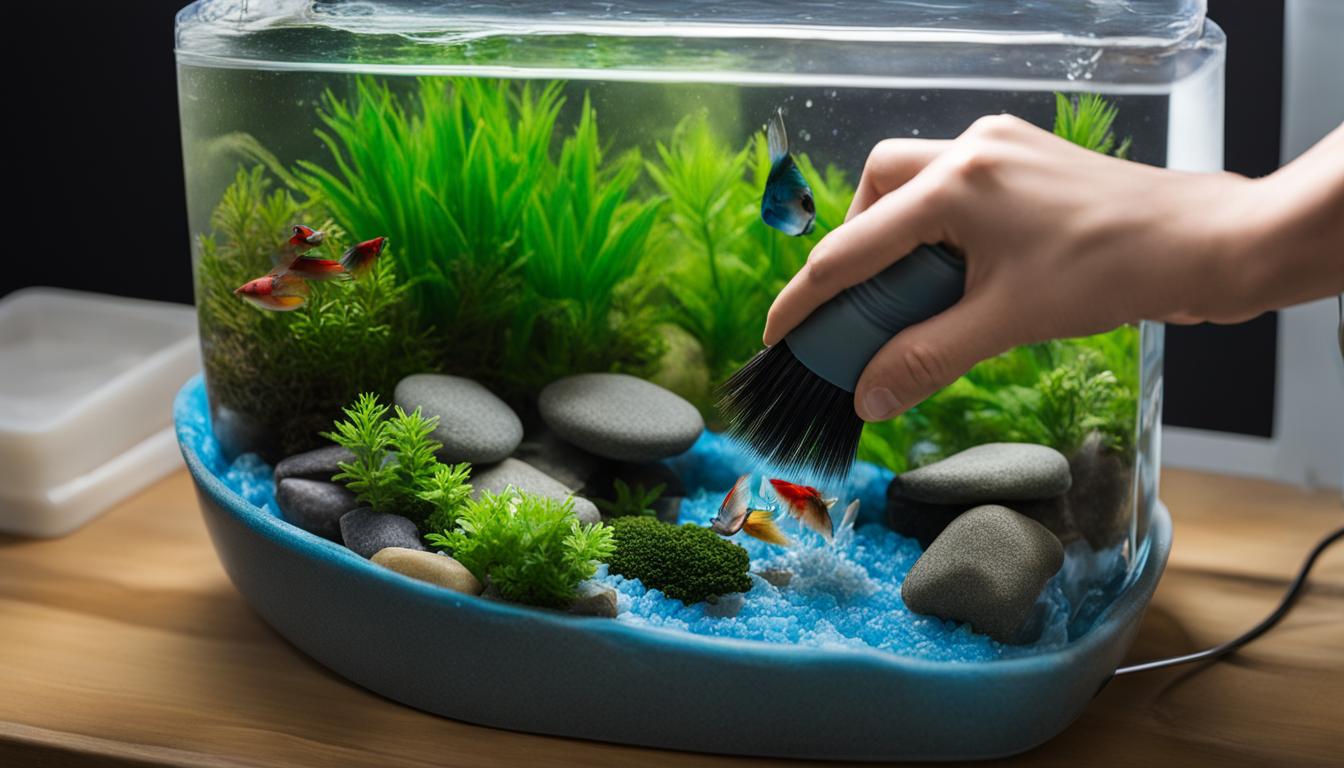Last Updated on 4 months by admin
If you are a betta fish owner, you know how important it is to maintain a clean and healthy tank for your pet. Regular cleaning and maintenance can ensure your betta fish live a happy and healthy life. In this article, we will give you a step-by-step guide on how to wash a betta fish tank. By following these simple steps, you can keep your betta fish tank clean and your fish happy.
Key Takeaways:
- Cleaning and maintaining a betta fish tank is crucial for the health and well-being of your pet.
- Prepare the replacement water by ensuring it is at the right temperature and treated with a water conditioner.
- Remove your betta fish from the tank before starting the cleaning process to prevent harm or stress.
- Clean the tank accessories, such as decorations, plants, and filters, to maintain a healthy tank environment.
- Regular maintenance, including water testing and partial water changes, is essential for a clean and healthy betta fish tank.
Why is Cleaning a Betta Fish Tank Important?
Regular cleaning and maintenance are essential for betta fish tank maintenance. Keeping the tank clean not only improves the health and well-being of the fish but also enhances the visual appeal of the tank.
A dirty and neglected tank can lead to several problems, including bacterial and fungal infections, poor water quality, and stress for the betta fish. Over time, uneaten food debris, waste, and other organic matter can accumulate in the tank, creating a breeding ground for harmful bacteria and algae that can harm the fish.
Moreover, betta fish require clean and well-oxygenated water to thrive. Without proper care and maintenance, the water can become stagnant and toxic, leading to health problems for the fish.
Therefore, it is crucial to clean and maintain the betta fish tank regularly. By doing so, you can ensure that your betta fish stays healthy and happy.
Betta Tank Cleaning Tips
Here are some betta tank cleaning tips to keep in mind:
- Perform partial water changes regularly to remove debris and maintain water quality.
- Test the water regularly to ensure it is well-oxygenated and free of harmful chemicals and toxins.
- Clean the tank accessories and decorations regularly to remove dirt and algae.
- Feed your betta fish a balanced diet and avoid overfeeding to prevent uneaten food debris from accumulating in the tank.
By following these tips, you can maintain a clean and healthy betta fish tank and provide your fish with a safe and comfortable home.

Gathering the Necessary Supplies
Before starting the cleaning process, it is essential to gather all the necessary supplies to ensure a thorough and effective job. Here are the essential items you will need:
| Supplies | Description |
|---|---|
| Siphon | A tube used to remove water and debris from the tank |
| Bucket | Used to hold the removed water and debris |
| Clean cloth | Used to wipe the tank’s surface and accessories |
| Water conditioner | Added to the replacement water to remove harmful chemicals and make it safe for the fish |
Make sure you have all the supplies on hand before you begin cleaning the betta fish tank. By having everything ready, you can streamline the process and ensure the best possible results.
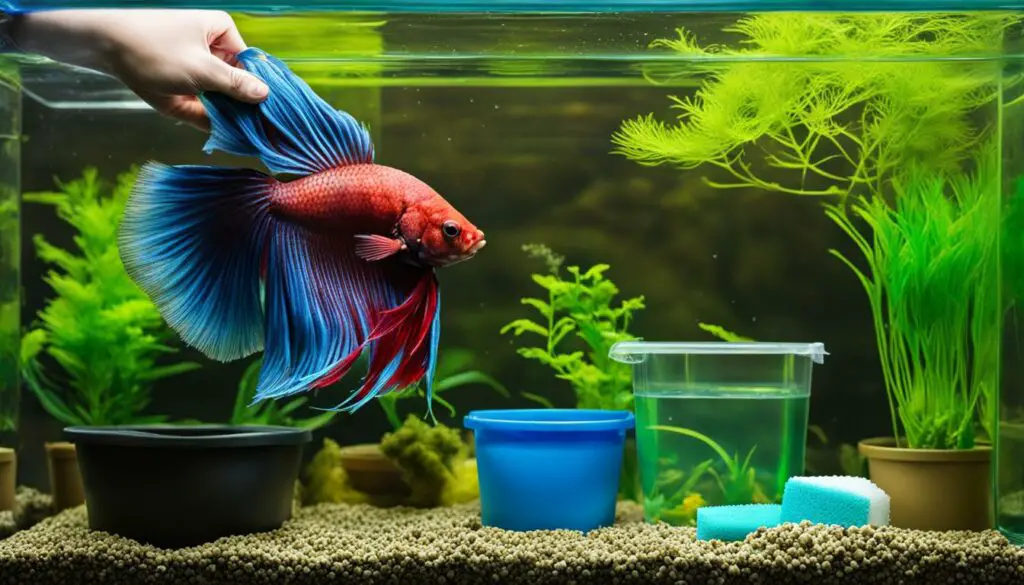
Step 1 – Prepare the Replacement Water
Before starting to clean the betta fish tank, it’s essential to prepare the replacement water. The new water must have the right temperature and be treated with a water conditioner, as untreated tap water contains harmful chemicals like chlorine that can harm the fish. The ideal water temperature for a betta fish tank should be between 76 and 82°F.
To prepare the replacement water, follow the instructions on the water conditioner bottle and add the appropriate amount of conditioner to the water. Once the water is treated, place it in a clean bucket or container and use a thermometer to check the temperature. If the water is too cold, use a heater to warm it up to the desired temperature.
Note: It’s essential to prepare this water in advance so that it’s ready to be used when needed.

Step 1 – Prepare the Replacement Water Tips:
- Use a high-quality water conditioner to remove any harmful chemicals from the tap water.
- Make sure that the new water is at the same temperature as the old water in the tank to prevent the fish from getting stressed.
- Prepare enough water to replace the old water in the tank.
Step 2 – Remove the Betta Fish from the Tank
Before starting the cleaning process, it’s important to remove your betta fish from the tank to avoid stressing or harming them. Here are the steps to follow:
- Prepare a temporary holding tank for your betta fish. This can be a clean and spacious bowl or bucket filled with water from the original tank.
- Use a clean net to gently catch the betta fish and transfer them to the temporary holding tank.
- Keep the temporary tank in a quiet and shaded area away from direct sunlight or drafts to avoid temperature fluctuations.
- Never use soap or any harsh chemicals to clean the net or the temporary tank, as residue can be harmful to your betta fish.
By following these steps, you can ensure that your betta fish stays safe and healthy while you clean their tank.
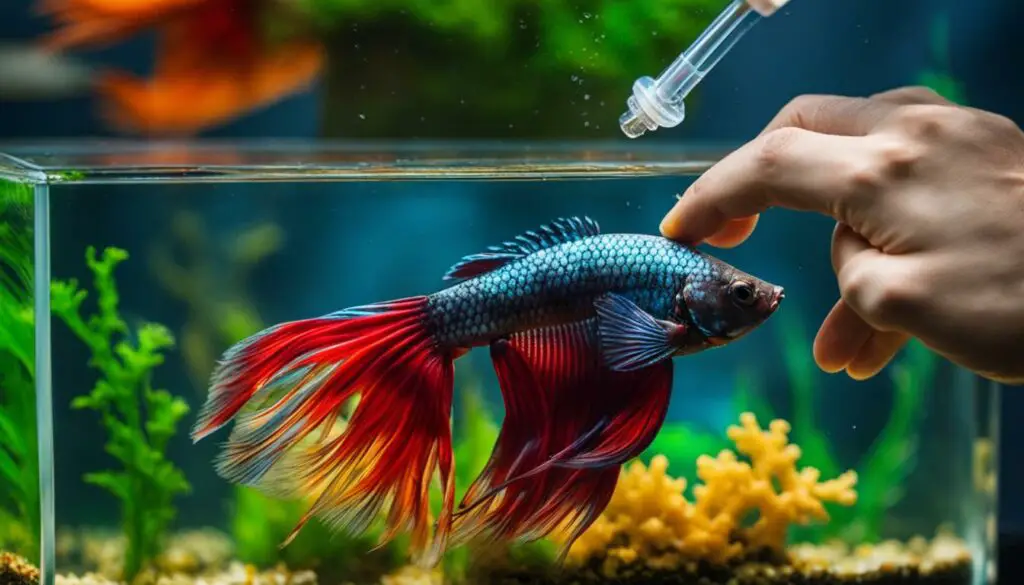
Step 3 – Empty and Rinse the Tank
Once you have removed your betta fish from the tank and prepared the replacement water, the next step is to empty and rinse the tank. This process is essential to remove any debris or waste that may have accumulated in the tank, ensuring a clean and healthy environment for your fish.
To begin, use a siphon to remove the old water from the tank, being careful not to disturb the gravel or decorations. The siphon works by creating a vacuum that sucks the water out of the tank and into a bucket for disposal.
Once you have emptied the tank, it’s time to give it a thorough rinse to remove any leftover residue. Start by using a clean cloth or sponge to wipe down the interior walls and surface of the tank, ensuring you remove any marks or stains. Next, rinse the tank with fresh water, ensuring you remove any traces of soap or cleaning agents that could harm your betta fish.
Easy betta tank cleaning method tip: If your tank has tough stains or marks that are difficult to remove, you can use a 50/50 solution of vinegar and water to give it a deeper clean. Simply apply the solution to a cloth or sponge, and wipe down the affected areas before rinsing thoroughly with fresh water.

| Do: | – Use a siphon to remove old water |
|---|---|
| – Clean the surfaces of the tank with a cloth or sponge | |
| – Rinse the tank with fresh water, removing all residue and cleaning agents | |
| – Consider using a vinegar and water solution for tough stains | |
| Don’t: | – Use soap or cleaning agents that could harm your betta fish |
Step 4 – Clean the Tank Accessories
After emptying and rinsing the tank, it’s time to clean the accessories. Tank decorations, plants, and filters can accumulate dirt and algae, which can affect the water quality and harm your betta fish.
Remove all the accessories from the tank and place them on a clean surface. Use a soft brush or sponge to gently scrub off any debris or build-up on the decorations and plants. Avoid using soap or cleaning agents, as they can be harmful to the fish. Rinse the accessories thoroughly with clean water and ensure there are no remaining particles or residue.
| Tip: | Consider rotating the decorations and plants in the tank to prevent the accumulation of dirt in one spot. |
|---|---|
 |
When cleaning the filter, it’s essential to follow the manufacturer’s instructions carefully. Generally, filters require regular maintenance, such as changing the filter cartridges, to ensure they function correctly and remove harmful substances from the water.
Once the accessories are cleaned and the filter is maintained, rinse everything thoroughly with clean water and let it dry before returning them to the tank.
Next Step: Step 5 – Clean the Tank Surface
Step 5 – Clean the Tank Surface
Now that the tank’s accessories are clean, it’s time to focus on the tank’s surface. Use a clean, non-toxic cloth or sponge to wipe down the inside of the tank. Ensure to remove all residue or marks, so the tank looks clean and clear.
If you notice any stubborn marks or debris, avoid using harsh chemicals or scrubbing the tank’s surface too vigorously, as this could damage the tank and harm the fish. Instead, try using a specialized aquarium cleaner that is safe for betta fish tanks. Be sure to follow the instructions carefully and use it sparingly.
After cleaning the tank’s surface, rinse it thoroughly with clean water. Then, dry the tank with a clean, dry cloth. Ensure it is entirely dry before moving on to the next step. Any residual moisture can promote the growth of harmful bacteria or algae, which can lead to health problems for your betta fish.
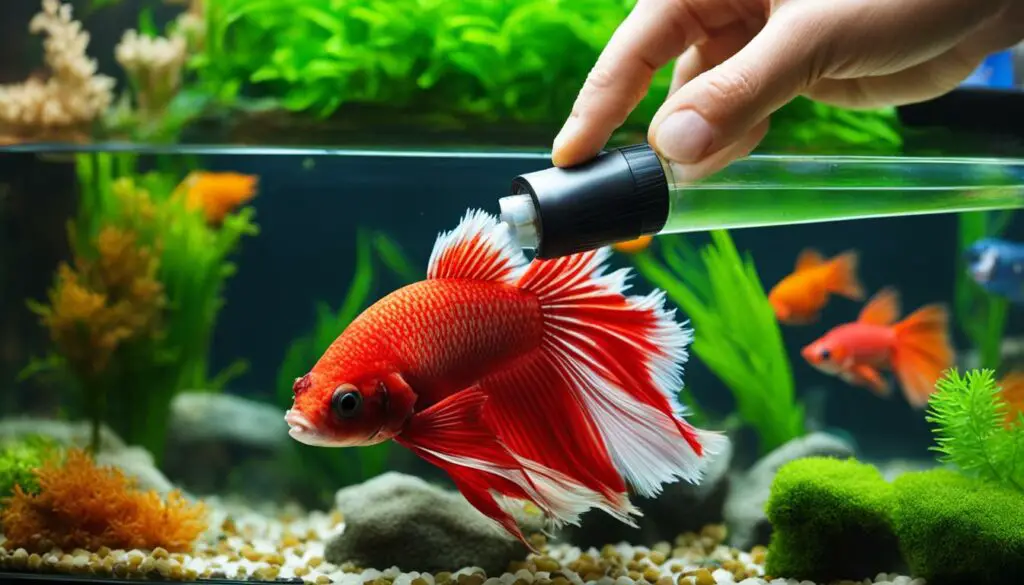
Tip: Regular maintenance can prevent the buildup of residue and marks on the tank’s surface, making it easier to clean and maintain over time. Consider scheduling a weekly cleaning routine to ensure your betta fish tank stays clean and clear.
Step 6 – Refill and Condition the Water
After thoroughly cleaning the betta fish tank, the next step is to refill it with the replacement water. Ensure that the water is clean, free of any debris, and treated with a water conditioner to remove harmful chemicals such as chlorine and chloramine. Properly conditioning the water is critical to maintaining a safe and healthy environment for the betta fish.
The best way to refill the tank is to use a siphon to add the replacement water slowly. This will prevent the water from splashing and disturbing the tank’s decorations and accessories. Be sure to add enough water to the tank, leaving at least one inch of space between the water surface and the top of the tank.
It is important to note that the temperature of the replacement water should match the temperature of the tank water, to avoid any sudden temperature changes that may cause stress or harm to the betta fish. The ideal temperature range for a betta fish tank is between 76 and 81 degrees Fahrenheit.
| Tip: | Use a thermometer to monitor the water temperature and ensure that the temperature is consistent before reintroducing the betta fish to the tank. |
|---|
Once the water is at the right temperature and properly conditioned, you can add it to the tank and turn on the tank’s filter and heater. Allow the water to circulate and the temperature to stabilize for at least 30 minutes before reintroducing the betta fish to the tank.
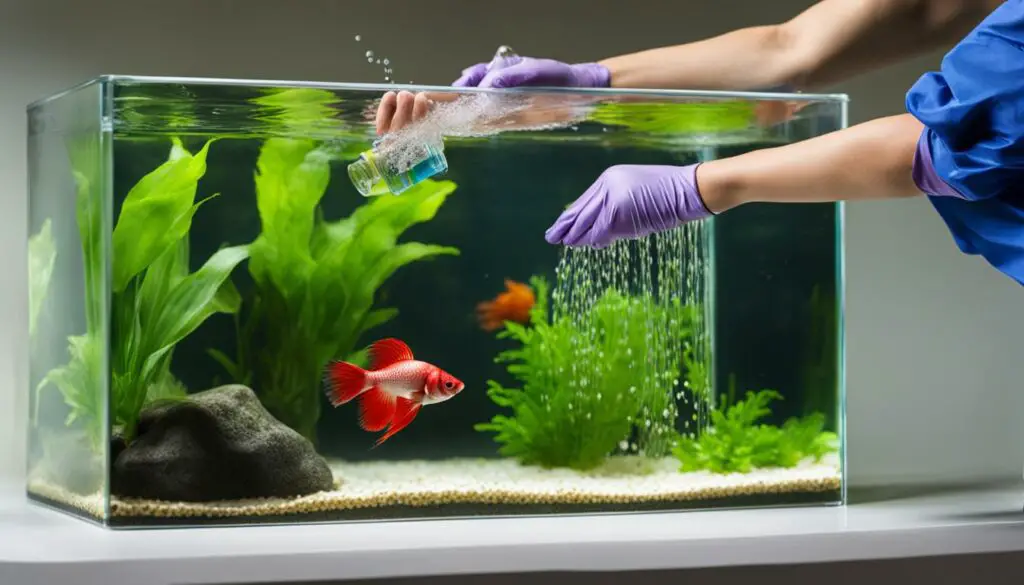
Properly refilling and conditioning the water is an essential step in maintaining the health and well-being of a betta fish. By following these steps, you can ensure that your betta fish tank remains clean and safe for your beloved pet to thrive in.
Step 7 – Reintroduce the Betta Fish to the Tank
Once the tank is clean and filled with fresh, conditioned water, it’s time to reintroduce the betta fish. It’s important to do this step carefully and slowly to avoid stressing or harming the fish.
First, turn off any filters or aerators to reduce water movement, which can be stressful for the fish.
Next, float the bag or container holding the betta fish on the surface of the tank for around 10-15 minutes. This will allow the temperature of the water in the bag to adjust to the temperature of the water in the tank, preventing shock.
After this time, open the bag or container and let some of the tank water into the bag, then wait for another 5-10 minutes.
Finally, use a fishnet to gently transfer the betta fish from the bag or container back into the tank.
It’s important to monitor the betta fish carefully for at least the first hour after reintroduction to ensure it’s adjusting well to the clean tank environment. If the fish appears to be stressed or lethargic, consider reducing the filter flow or adding hiding places such as plants or caves to provide a sense of security.

Regular Maintenance Tips for Betta Fish Tanks
Betta fish tanks require regular maintenance to ensure the health and well-being of your fish. Here are some tips to help you maintain a clean and healthy tank:
- Perform regular water testing: Test your tank water regularly to check the pH level, ammonia, nitrites, and nitrates. This will help you identify any issues and make necessary adjustments to keep your tank water clean and healthy for your betta fish.
- Perform partial water changes: Do partial water changes of about 25% every week to remove any excess waste and debris from the tank. This will help reduce the nitrate levels and maintain a healthy environment for your betta fish.
- Clean tank accessories: Clean your tank accessories, including filters, plants, and decorations, regularly to remove any accumulated dirt or algae. This will help prevent the spread of harmful bacteria and keep your tank looking clean and fresh.
- Adjust feeding practices: Overfeeding your betta fish can lead to excess waste and pollution in the tank. Feed your fish only what they can consume in a few minutes, and remove any excess food to avoid polluting the water.
- Monitor fish behavior: Observe your betta fish regularly to monitor their behavior and ensure that they are healthy and active. If you notice any changes in behavior, such as lethargy or loss of appetite, it may be a sign of illness or stress.
- Keep the tank clean: Regularly clean the tank surface and remove any debris or marks using a clean cloth or sponge. This will help maintain a clear and visually appealing tank that your betta fish can thrive in.
By following these tips and regularly maintaining your betta fish tank, you will ensure the health and well-being of your fish and enjoy a clean and beautiful tank for years to come.
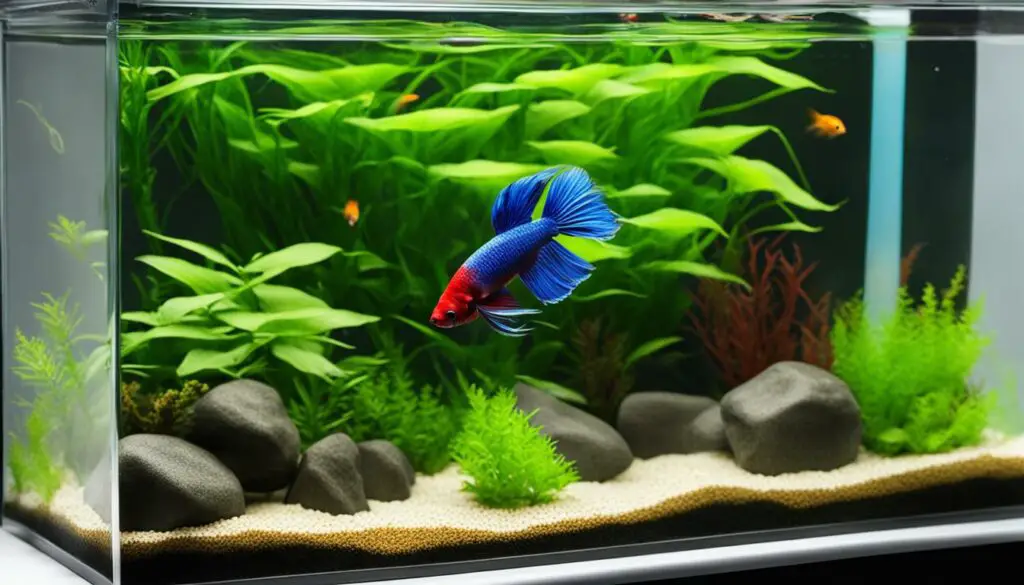
Conclusion
Regular cleaning and maintenance are vital for ensuring the health and well-being of your betta fish. By following the simple steps outlined in this guide on how to wash a betta fish tank, you can provide your fish with a clean and safe environment to thrive in.
Remember, it’s not enough just to clean the tank once and forget about it. Betta fish tank care requires ongoing attention and maintenance, such as regular water testing, partial water changes, and proper feeding practices.
By taking the time to care for your betta fish and their environment, you’ll enjoy the rewards of a healthy and happy pet. So don’t wait, start implementing these tips and guidelines today to ensure your betta fish thrive for years to come!
FAQ
Why is cleaning a betta fish tank important?
Regular cleaning and maintenance of a betta fish tank is important for the health and well-being of the fish. It helps remove waste, excess nutrients, and harmful chemicals from the tank, ensuring a clean and safe environment.
What supplies do I need to clean a betta fish tank?
To clean a betta fish tank, you will need a siphon, a bucket, a clean cloth or sponge, and a water conditioner to treat the replacement water.
How do I prepare the replacement water?
Start by filling a bucket with tap water and treating it with a water conditioner to remove harmful chemicals. Make sure the water is at the right temperature for your betta fish (around 78-80°F) before adding it to the tank.
How can I safely remove the betta fish from the tank?
To remove the betta fish from the tank, use a small net or cup and gently scoop the fish out of the water. Avoid using your hands or any sharp objects that can harm the fish.
How do I empty and rinse the tank?
Start by carefully pouring out the old water from the tank into the sink or a bucket. Then, use clean water to rinse the tank, removing any debris or waste. Be gentle to avoid damaging any decorations or equipment in the tank.
How do I clean the tank accessories?
Remove any decorations, plants, or filters from the tank and clean them separately. Use a soft brush or sponge and mild soap or vinegar to scrub away dirt or algae. Rinse them thoroughly before placing them back in the tank.
How should I clean the tank’s surface?
Use a clean cloth or sponge to wipe the tank’s surface, removing any residue or marks. Avoid using harsh chemicals or abrasive materials that can harm the tank or the fish.
How do I refill and condition the water?
Fill the tank with the prepared replacement water, making sure it is at the right temperature and treated with a water conditioner. Follow the instructions on the conditioner’s packaging for proper dosage.
How do I reintroduce the betta fish to the tank?
Gently place the betta fish back into the clean tank using a net or cup. Take your time to acclimate the fish to the new water temperature by floating the container with the fish in the tank for a few minutes before releasing them.
What are some maintenance tips for betta fish tanks?
Regular maintenance tips for betta fish tanks include conducting water tests, performing partial water changes, feeding the fish properly, and keeping the tank free of excess waste or debris. Monitor the water quality and maintain a consistent cleaning schedule.
What is the importance of maintaining a clean betta fish tank?
Maintaining a clean betta fish tank is crucial for the health and well-being of the fish. It helps prevent the buildup of harmful bacteria, maintains water quality, and provides a suitable habitat for the betta fish to thrive.

